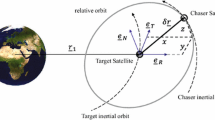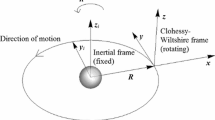Abstract
Assume that a constellation of satellites is required to remain close to a given nominal trajectory and that there is some freedom in the selection of the geometry of the constellation. If we are interested in avoiding large variations of the mutual distances between the spacecraft, we can consider the possible existence of regions of zero relative radial acceleration with respect to the nominal trajectory. The motion along these regions will reduce the expansion or contraction of the constellation. The goal of this paper is the study of these regions and the controlled motions between them.
Similar content being viewed by others
References
BEARD, R. “Architecture and Algorithms for Constellation Control,” Technical Report CA–91109, Jet Propulsion Laboratory, 1998.
BEARD, R. and HADAEGH, F. “Finite Thrust Control for Satellite Formation Flying with State Constraints,” Proceedings of the American Control Conference, 1999, pp. 4383–4387.
BEARD, R. and HADAEGH, F. “Fuel Optimization for Unconstrained Rotation of Spacecraft Formation,” The Journal of the Astronautical Sciences, Vol. 43, No. 3, July-September 1999, pp. 259–273.
BEARD, R. and HADAEGH, F. “Fuel Optimized Rotation for Satellite Formations in Free Space,” Proceedings of the American Control Conference, 1999, pp. 2975–2979.
BEARD, R. and LAIN, T. M. “Fuel Optimization for Constrained Rotation of Spacecraft Formations,” Journal of Guidance, Control and Dynamics, Vol. 23, No. 2, 2000, pp. 339–346.
GÓMEZ, G., JORBA, À., MASDEMONT, J., and SIMÓ, C. Dynamics and Mission Design Near Libration Point Orbits—Volume 3: Advanced Methods for Collinear Points, World Scientific, 2001. Reprinted from ESA Technical Report “Study Refinement of Semi-Analytical Halo Orbit Theory,” 1991.
GÓMEZ, G., JORBA, À., MASDEMONT, J., and SIMÓ, C. Dynamics and Mission Design Near Libration Point Orbits—Volume 4: Advanced Methods for Triangular Points, World Scientific, 2001. Reprinted from ESA Technical Report “Study on Orbits near the Triangular Libration Points in the Perturbed Restricted Three-Body Problem,” 1993.
JORBA, À. and MASDEMONT, J. J. “Dynamics in the Center Manifold of the Restricted Three-Body Problem,” Physica D, Vol. 132, 1999, pp. 189–213.
MCINNES, C. “Autonomous Proximity Monoeuvering Using Artifitial Potential Functions,” ESA Journal, Vol. 17, 1993, pp. 159–169.
MCINNES, C. “Autonomous Rendezvous Using Artifitial Potential Functions,” Journal of Guidance, Control and Dynamics, Vol. 18, 1995, pp. 237–241.
MCINNES, C. “Autonomous Ring Formation for a Planar Constellation of Satellites,” Journal of Guidance, Control and Dynamics, Vol. 18, No. 5, 1995, pp. 1215–1217.
MCINNES, C. “Potential Function Methods for Autonomous Spacecraft Guidance and Control,” Advances in the Astronautical Sciences, Vol. 90, 1996, pp. 2093–2109.
SZEBEHELY, V. Theory of Orbits, Academic Press, 1967.
Author information
Authors and Affiliations
Corresponding author
Rights and permissions
About this article
Cite this article
Gómez, G., Marcote, M., Masdemont, J.J. et al. Zero Relative Radial Acceleration Cones and Controlled Motions Suitable for Formation Flying. J of Astronaut Sci 53, 413–431 (2005). https://doi.org/10.1007/BF03546361
Published:
Issue Date:
DOI: https://doi.org/10.1007/BF03546361




